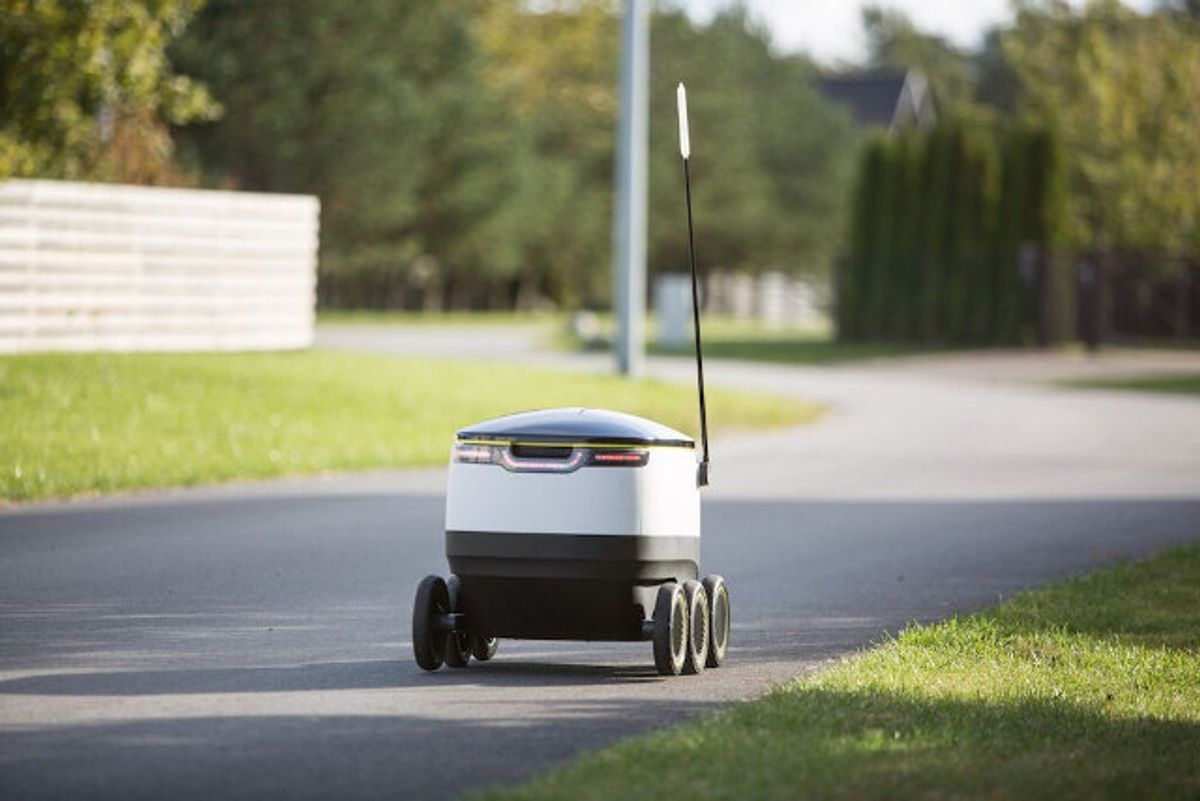We’re pretty sure that delivery drones aren’t going to be a thing anytime soon. The reason that so many companies are breathlessly promising that it’s right around the corner is because having robots deliver stuff to you whenever you want it is a fantastic idea. At first, drones seem like a good idea because flying lets you get to places quickly while avoiding obstacles, and people have been stuck on this idea for years because it would be great if you could actually get it to work.
So far, it hasn’t worked, but that doesn’t mean that robots delivering things shouldn’t happen. And really, do consumers care whether it’s delivered specifically by autonomous aerial drone as long as they get their stuff relatively quickly and don’t have to change out of their pajamas? A startup called Starship Technologies, with offices in London and Tallinn, Estonia, has announced an autonomous delivery robot that promises to do everything that a delivery drone can do (and more), except from the ground and with a realistic chance of actually happening.
Launched by two Skype co-founders, Ahti Heinla (who serves as CEO and CTO) and Janus Friis, Starship Technologies will introduce fleets of compact, safe, quiet, and best of all, earthbound delivery robots, hoping to open up new opportunities for businesses such as parcel delivery firms or grocery stores and create unprecedented convenience and cost savings for individuals.
The robot, which as far as I can tell doesn’t have a name, can carry the equivalent of two grocery bags (around 10 kilograms) up to 5 kilometers from a local hub or retail outlet. It moves at walking pace, and fully loaded weighs less than 20 kg, meaning that it would be difficult for the machine to accidentally hurt anyone. Curbs and bumps on the road are no problem, and they robot can apparently make it up and down some sets of stairs. Integrated navigation and obstacle avoidance software enables it to drive mostly on its own, but it’s also overseen by human operators who can step in to ensure safety at all times.

Starship estimates that its robotic deliveries will cost 10 to 15 times less than current last-mile delivery alternatives. Customers will be able to choose from a selection of short, precise delivery slots, meaning goods arrive at a time that suits them, according to the company. During delivery, shoppers can track the robot’s location in real time through a mobile app and on arrival only the app holder is able to unlock the cargo.

We’re not saying that getting these robots to work will be easy, necessarily: while drones are comparatively more dangerous, less reliable, noisier, more expensive, payload limited, and currently in legal limbo, Starship’s robots will have to tackle all kinds of problems that delivery drones completely avoid. These challenges include finding their way around roads and sidewalks, navigating next to vehicles and around pedestrians, and interacting more directly with humans. What’s more, GPS isn’t accurate enough to keep these robots on sidewalks, so they’ll have to use vision to be able to tell where it’s safe to go, relying on basemap localization like Google’s autonomous cars do. They’ll need to be able to understand pedestrian crossings and traffic lights. They’ll have to listen for and properly react to sirens from emergency vehicles. And perhaps hardest of all, they’ll have to detect and communicate with unpredictable humans.
Still, we’re optimistic about this because we’ve seen a lot of the necessary technologies already at work. Robots in general have a lot of practice at safe urban navigation. They’re excellent at dynamically avoiding obstacles given enough time and adequate sensor data. There are entire conferences on how to get robots to interact with humans in an effective way. Most importantly, if any of this stuff doesn’t work, the robot can safely stop and wait indefinitely for a human to step in and help it out, with cameras and speakers and microphones allowing for full telepresence and remote control.
It’s certainly worth pointing out that Aethon, Savioke, and other robotics companies have been doing something very similar to this successfully for years now. Delivering items by wandering around in hospitals, warehouses, and hotels has different challenges from delivering items by wandering around streets, but fundamentally, similar technologies are used, and the fact that these companies have gotten it to work reliably makes us optimistic that Starship will be able to as well.
Starship is actively testing prototypes right now, and by next year, the company will be launching two pilot programs: one in Greenwich in East London, and one in the United States.
Evan Ackerman is a senior editor at IEEE Spectrum. Since 2007, he has written over 6,000 articles on robotics and technology. He has a degree in Martian geology and is excellent at playing bagpipes.



